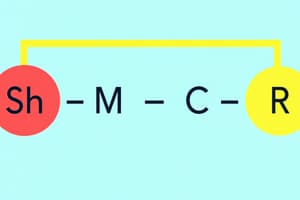Podcast
Questions and Answers
In the scenario involving Mr. Arellano and Mrs. Villaver, who is identified as the sender of the message?
In the scenario involving Mr. Arellano and Mrs. Villaver, who is identified as the sender of the message?
- The rural health unit
- The mayor
- Mr. Arellano (correct)
- The head nurse
What is the primary barrier to effective communication observed in the scenario?
What is the primary barrier to effective communication observed in the scenario?
- Differences in professional roles
- Noise during transmission (correct)
- Lack of proper feedback
- Misunderstanding of the message
Which element is NOT a part of Berlo's model of communication?
Which element is NOT a part of Berlo's model of communication?
- Message
- Receiver
- Source
- Transmission error (correct)
What role does feedback play in the communication scenario provided?
What role does feedback play in the communication scenario provided?
Which of the following statements best illustrates the function of a communication model?
Which of the following statements best illustrates the function of a communication model?
Flashcards are hidden until you start studying
Study Notes
Communication Models
- Models of communication are visual representations that explain how communication works.
- They are a tool to understand the various parts of communication and how they interact with each other.
Scenario
- Sender: Mr. Arellano, the mayor's secretary
- Message: "Mrs. Villaver, you are called for an emergency meeting this afternoon".
- Noise: Transmission error, causing the head nurse to only hear "called for."
- Receiver: Mrs. Villaver, the head nurse.
- Feedback: Present, Mrs. Villaver asking "I'm sorry but what is that you are calling for, sir?"
Effective Communication
- The second situation is more effective communication because the receiver provided feedback to clarify the message, ensuring understanding.
Berlo Model of Communication
- The Berlo Model of Communication emphasizes the importance of the sender, receiver, and the message.
- Elements:
- Source: The sender of the message.
- Encoding: The process of putting thoughts into a form that can be transmitted.
- Message: The content being conveyed.
- Channel: Path used to transmit the message.
- Decoding: The process of interpreting the message received.
- Receiver: The person who receives the message.
- Feedback: The receiver's response to the message.
Importance of the Berlo Model
- The Berlo Model highlights that effective communication is based on the connection between the sender and the receiver.
- It explains how a sender's skills, attitudes, knowledge, and social system influence the message they create.
- The receiver's skills, attitudes, knowledge, and social system also influence how they decode the message.
- Both sender and receiver need clarity, shared understanding, and effective communication skills to ensure accurate communication.
Studying That Suits You
Use AI to generate personalized quizzes and flashcards to suit your learning preferences.




